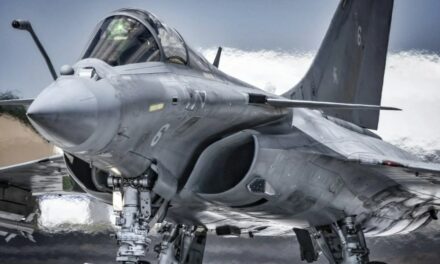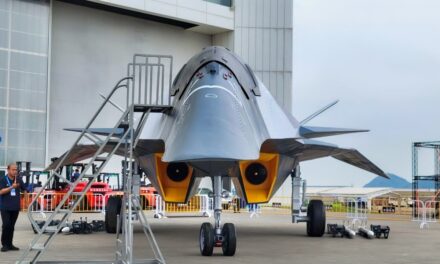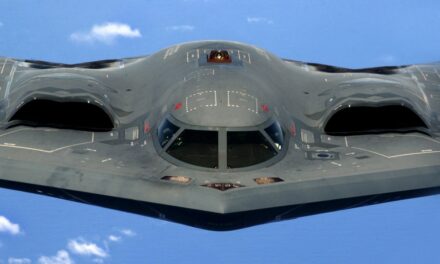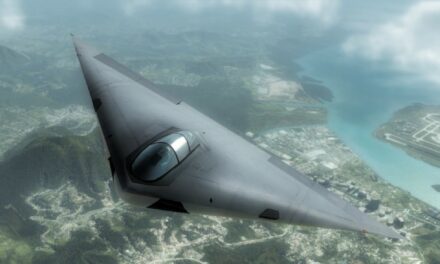We support our Publishers and Content Creators. You can view this story on their website by CLICKING HERE.
Key Points: The Lockheed Martin X-44 MANTA (Multi-axis, No Tail Aircraft) was a late-1990s proposal for a tailless delta-wing stealth fighter.
-Designed for increased stealth, agility, and range, the MANTA featured internal weapons bays, a low-drag airframe, and thrust vectoring for maneuverability.
-With specs including MACH 2 speed, a range of 2,000 miles, and advanced radar-evading features, the X-44 was innovative but ultimately canceled in 2000 due to technical and cost concerns.
-Despite never reaching production, the X-44 influenced modern stealth and fighter concepts, particularly for the Next-Generation Air Dominance (NGAD) program.
X-44 MANTA: A Proposed Fighter That May Be Seen as Very Influential – Before the F-22 Raptor came to fruition, there was the Lockheed Martin X-44 Manta.
The X-44 was a proposed warbird that was never produced, but it had excellent conceptual aspects ahead of its time.
Devised in the late 1990s, the X-44 had no vertical stabilizers, a design aspect that was thought to increase stealthiness. The tail-less delta-shape design was innovative. Twin turbofan engines with thrust vectoring would create high speed and agility. Despite these promising attributes, the X-44 program was shut down in 2000.
Manta stood for Multi-axis, No Tail Aircraft. The Manta would have no tailplanes. The X-44 was also envisioned as having internal weapons bays. The Manta would also carry enviable amounts of internally-stored fuel to increase its range.
X-44 Manta: Fast, Stealthy, and Rangy
The X-44’s design allowed for some impressive specs. The engineers believed the X-44 would travel at MACH 2, with its twin Pratt & Whitneys generating 35,000 pounds of thrust. It could have hit a ceiling of 49,000 feet and a range of nearly 2,000 miles.
The X-44 Manta would have low drag for better performance and radar evasion. The weapons bays could have carried a diverse assortment of weapons such as Sidewinders, AMRAAMs, and precision-guided munitions.
Good Aspects and Bad
As with any proposed advanced fighter that never made it to serial production, there were pros and cons.
As Emily Davis of BuzzHint wrote in 2024:
“The tailless design of the X-44 Manta had some great benefits, including broadband low-observability, drag reduction to sustain high-speed dashes, and increased fuel capacity. However, the stability and maneuverability issues created from removing vertical tails could only be partially compensated for by thrust vectoring.”
Does it Help the NGAD Program?
The X-44 Manta proposal was a significant development for future fighters. The Next-generation Air Dominance (NGAD) fighter will likely take on aspects of the X-44’s best attributes. But can these types of stealth airplanes still “dominate” in the era of hypersonic missiles? Yes, the Manta was designed to be stealthy, but could its best features result in the type of maneuverability that would be needed in a dogfight with China’s own stealth fighters?
Image: Lockheed Martin.
Created for an Eye on the Future
Due to the X-44 only emerging as a proposed alternative, we will never know the answers to these questions. But the designers of the X-44 should be commended for creating a concept that was ahead of its time. The design was simple, and the airframe would have been light, so that would have probably increased the level of agility in a dogfight. No gaps in the airframe would have yielded greater radar evasion.
X-44: Expensive to Keep In the Air
However, another unknown about the X-44 would have been the level of maintenance that would be required to preserve its airworthiness. The unit cost and total price tag of the X-44 (should it have become the F-44) could have been prohibitive. Indeed, the NGAD program is going to be super expensive at $300 million each, and the Air Force has even placed a “pause” on its development.
Thus, the U.S. military passed on the X-44 and leaned into production of the F-35 and F-22. The demise of the Manta should not be seen as a total loss. It was a unique bird with many attributes. The design was cutting-edge, and the stealthiness would have been commendable. The question would have been survivability in a dogfight. It may not have been as maneuverable as advertised.
It also may not have outrun hypersonic missiles fired from the enemy. Moreover, it was not designed to team with an unmanned bird in the Loyal Wingman concept. The cost per flight hour would have likely been high, and the maintenance requirements were unknown. All is not lost with the Manta; it should aid the NGAD program and help designers and engineers create the new 6th generation fighter. The Manta should not be seen as a failure but as a stepping stone, and that’s worth the time, money, and effort spent on the proposed design.
About the Author: Dr. Brent M. Eastwood
Brent M. Eastwood, PhD, is the author of Don’t Turn Your Back On the World: a Conservative Foreign Policy and Humans, Machines, and Data: Future Trends in Warfare, plus two other books. Brent was the founder and CEO of a tech firm that predicted world events using artificial intelligence. He served as a legislative fellow for U.S. Senator Tim Scott and advised the senator on defense and foreign policy issues. He has taught at American University, George Washington University, and George Mason University. Brent is a former U.S. Army Infantry officer. He can be followed on X @BMEastwood.

 Conservative
Conservative  Search
Search Trending
Trending Current News
Current News 





